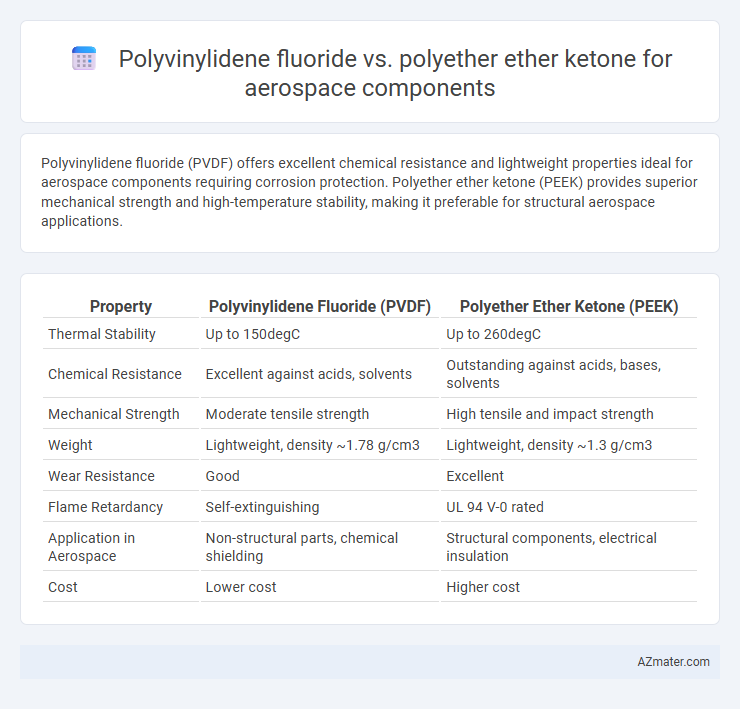Polyvinylidene fluoride (PVDF) offers excellent chemical resistance and lightweight properties ideal for aerospace components requiring corrosion protection. Polyether ether ketone (PEEK) provides superior mechanical strength and high-temperature stability, making it preferable for structural aerospace applications.
Table of Comparison
| Property | Polyvinylidene Fluoride (PVDF) | Polyether Ether Ketone (PEEK) |
|---|---|---|
| Thermal Stability | Up to 150degC | Up to 260degC |
| Chemical Resistance | Excellent against acids, solvents | Outstanding against acids, bases, solvents |
| Mechanical Strength | Moderate tensile strength | High tensile and impact strength |
| Weight | Lightweight, density ~1.78 g/cm3 | Lightweight, density ~1.3 g/cm3 |
| Wear Resistance | Good | Excellent |
| Flame Retardancy | Self-extinguishing | UL 94 V-0 rated |
| Application in Aerospace | Non-structural parts, chemical shielding | Structural components, electrical insulation |
| Cost | Lower cost | Higher cost |
Introduction to High-Performance Polymers in Aerospace
Polyvinylidene fluoride (PVDF) and Polyether ether ketone (PEEK) are high-performance polymers increasingly used in aerospace for their exceptional thermal stability and chemical resistance. PEEK offers superior mechanical strength and higher temperature tolerance up to 250degC, making it ideal for structural components subjected to extreme conditions. PVDF provides excellent resistance to UV radiation and weathering, suitable for protective coatings and insulation in aerospace environments.
Overview of Polyvinylidene Fluoride (PVDF)
Polyvinylidene fluoride (PVDF) is a high-performance thermoplastic known for its excellent chemical resistance, UV stability, and durability, making it suitable for aerospace components exposed to harsh environments. Its inherent piezoelectric properties enable advanced sensing applications and lightweight structural parts, while its good processability supports complex aerospace designs. PVDF's resistance to high temperatures up to 150degC and its low outgassing characteristics meet critical aerospace industry standards.
Overview of Polyether Ether Ketone (PEEK)
Polyether Ether Ketone (PEEK) is a high-performance thermoplastic extensively used in aerospace components due to its exceptional mechanical strength, thermal stability up to 250degC, and excellent chemical resistance. PEEK's low flammability and inherent resistance to radiation and hydrocarbon exposure make it ideal for critical aerospace applications requiring durability and lightweight properties. Its superior wear resistance and dimensional stability under stress contribute to enhanced component longevity compared to standard polymers like Polyvinylidene Fluoride (PVDF).
Mechanical Properties: PVDF vs PEEK
Polyether ether ketone (PEEK) offers superior mechanical properties compared to polyvinylidene fluoride (PVDF) for aerospace components, including higher tensile strength, greater stiffness, and excellent fatigue resistance, making it ideal for load-bearing applications. PEEK also demonstrates exceptional thermal stability up to 250degC, whereas PVDF's operating temperature range is significantly lower, around 150degC, limiting its mechanical performance under high heat conditions. While PVDF provides good chemical resistance and flexibility, PEEK's combination of mechanical strength and durability under extreme aerospace environments positions it as the preferred material for critical structural parts.
Thermal Stability and Heat Resistance Comparison
Polyether ether ketone (PEEK) exhibits superior thermal stability and heat resistance compared to polyvinylidene fluoride (PVDF), with a melting point around 343degC versus PVDF's 177degC, making PEEK more suitable for aerospace components exposed to high-temperature environments. PEEK maintains mechanical integrity and dimensional stability at temperatures exceeding 250degC, whereas PVDF typically degrades or loses strength beyond 150degC. The enhanced thermal properties of PEEK support critical aerospace applications that require prolonged exposure to elevated temperatures without compromising material performance.
Chemical Resistance: Suitability for Aerospace Environments
Polyvinylidene fluoride (PVDF) exhibits exceptional chemical resistance to acids, bases, and solvents, making it ideal for aerospace components exposed to harsh chemical environments. Polyether ether ketone (PEEK) also demonstrates excellent chemical stability, with superior resistance to hydrocarbons and aggressive aerospace fuels. Both polymers maintain integrity under extreme temperatures and corrosive conditions, but PEEK offers enhanced durability for long-term aerospace applications requiring high mechanical strength and chemical endurance.
Weight and Density Considerations
Polyvinylidene fluoride (PVDF) exhibits a lower density of approximately 1.78 g/cm3, contributing to significant weight savings in aerospace components compared to Polyether ether ketone (PEEK), which typically has a density around 1.30-1.32 g/cm3. While PEEK offers superior mechanical strength and thermal stability, PVDF's lighter weight makes it advantageous for applications where reducing overall component mass is critical to performance and fuel efficiency. Weight and density considerations play a pivotal role in material selection, with PVDF often preferred for non-structural parts requiring lower weight and PEEK chosen for load-bearing aerospace components demanding high durability.
Processability and Manufacturing Techniques
Polyvinylidene fluoride (PVDF) offers superior processability in aerospace components due to its excellent melt flow properties, allowing for precision molding and extrusion techniques that enhance manufacturing efficiency. Polyether ether ketone (PEEK), while more challenging to process because of its high melting point (approximately 343degC), requires advanced methods like compression molding and high-temperature injection molding, which result in components with exceptional mechanical strength and thermal stability. The choice between PVDF and PEEK hinges on balancing ease of manufacturing with the performance demands of aerospace applications, where PEEK's superior chemical resistance and thermal endurance often justify the more complex processing requirements.
Cost Analysis and Economic Impact
Polyvinylidene fluoride (PVDF) offers a lower initial material cost compared to Polyether ether ketone (PEEK), making it a more budget-conscious choice for aerospace components with moderate performance requirements. PEEK's superior thermal stability and mechanical strength justify its higher price through extended service life and reduced maintenance costs in high-performance aerospace applications. The economic impact favors PVDF for cost-sensitive projects, while PEEK delivers long-term value by minimizing lifecycle expenses and enhancing component reliability.
Application Case Studies in Aerospace Components
Polyvinylidene fluoride (PVDF) demonstrates superior chemical resistance and excellent weatherability, making it ideal for fuel system components and coating applications in aerospace environments exposed to harsh conditions. Polyether ether ketone (PEEK) offers outstanding mechanical strength, high thermal stability, and resistance to wear, commonly used in structural aerospace parts such as bearing cages, insulation components, and high-performance fasteners. Case studies highlight PVDF's effectiveness in lightweight composite coatings for corrosion protection, while PEEK excels in load-bearing components subjected to extreme temperatures and mechanical stresses.

Infographic: Polyvinylidene fluoride vs Polyether ether ketone for Aerospace Components
 azmater.com
azmater.com